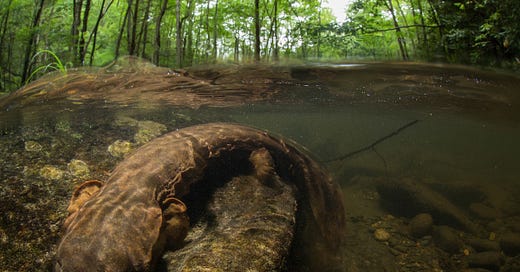Hellbenders in East Tennessee
David Herasimtschuk’s photo of a Hellbender appears courtesy of Freshwaters Illustrated, also producers of a video of hellbenders in Appalachian streams. Freshwaters Illustrated has worked tirelessly for two decades to bring the story of rivers and streams to audiences nationwide. Their films include Hidden Rivers of Southern Appalachia. You can learn more about their educational initiatives on their website.
Thanks to Casper Cox for connecting me with Freshwaters Illustrated and obtaining permission to use the photo. Casper is an avid freshwater snorkeler and photographer. He appeared in the Hidden Rivers film and wrote the companion book, Snorkeling the Hidden Rivers of Southern Appalachia.
According to the National Zoo (a division of the Smithsonian Institution), hellbenders can reach 5 pounds and 29 inches. They require clean, well-oxygenated water.
My interest in hellbenders began when I wrote for their namesake publication, The Hellbender Press of Knoxville, Tennessee from 2003 through 2008. I read about these iconic creatures and my interest grew when I saw one in an exhibit at the Tennessee Aquarium.
The Hellbender Press was reborn as a digital publication in 2020. My 2021 article for the new publication resulted from an interview with Will Ternes of the Chattanooga Zoo. He was working on hellbender restoration.
On Wednesday, October 23 this year, I attended Will’s presentation in Chattanooga for the South Chickamauga Creek Greenway Alliance. He spoke about the Hellbender Head Start Program. Will appears in this video about hellbender restoration on Facebook.
I was delighted to hear about how the project has progressed. Though much of the information also appeared in my article, I was pleased to learn that our zoo is still collecting eggs from Hellbenders and rearing the young for release in the wild.
One new factor that Ternes mentioned was that hellbender reintroduction programs have learned to release the hellbenders when they reach 5 ½ inches. Despite their small size, they are more likely to survive in the wild. Animals they held longer became too accustomed to captivity and being fed.
My interview with Ternes was the first of four conversations with hellbender experts. I had read John McPhee’s book Draft # 4 and wanted to do comprehensive stories. I had published such articles on other subjects in The Appalachian Voice of Boone North Carolina. One was about freshwater snorkeling and the other was about people who watch the fall hawk migration and count the Broad Winged Hawks. This second article involved four interviews. This style didn’t work well for The Hellbender Press, so I produced shorter articles.
While gathering information, I spoke to Dr. Michael Freake of Lee University. He now works closely with the zoo in the restoration and has appeared in YouTube videos about hellbenders. I gained background information but produced no publication.
Dr. Freake is particularly knowledgeable about the role of environmental DNA (eDNA) in the research. This Chattanooga Times Free Press article by Pam Sohn recognized the importance of his work a few years ago.
I later corresponded with Dr Brian Miller of Middle Tennessee State University by email and he told me about the Hellbenders of Tennessee’s Highland Rim Physiographic Province. He had researched hellbenders in the Collins River and the Buffalo River.
Dr. Miller indicated that he could tell if a population of hellbenders was in trouble if fieldwork revealed many older adults and few young ones. He also stressed the importance of streambank health since siltation harms hellbenders.
I had not known that Hellbenders lived on the Highland Rim and learned they were not doing well there. My article from that interview was my second in The Hellbender Press.
I also spoke to Dr. Bill Sutton of Tennessee State University. Sutton worked with both subspecies of hellbenders. He emphasized the importance of clean, well-oxygenated water and healthy stream banks. In the interview, I learned of the impact of chytrid fungus on hellbender populations, including its role in limb loss.
I stubbornly continued to read popular articles and a few scientific papers on the subject. I stopped looking into the hellbender research and restoration when I became convinced that further publications were unlikely. I later wrote an article about freshwater snorkeling in North Carolina.
The final word on the subject comes from Freshwaters Illustrated.
Book Presale
I am still looking forward to my poetry book launching at Clear Story Arts in Chattanooga on Friday, November 1. Here is a direct link to the presale order form on the publisher’s website. The book will be available in Chattanooga Area Bookstores after the launch, and I am looking for opportunities to do readings and signings within a two-hour radius of Chattanooga. A recent interview by Deborah Z Adams includes additional information about the book.




